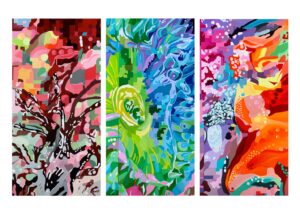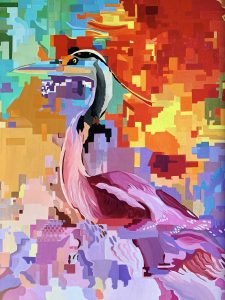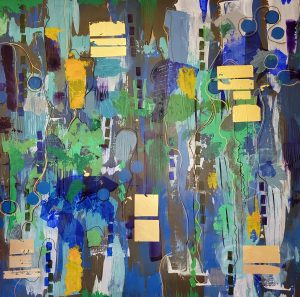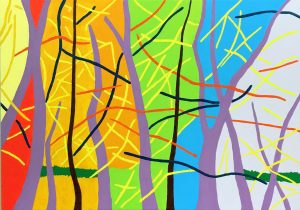
Polychromatic Worlds opens Saturday, March 9 at 4 pm in the Coleman Hall featuring the work of Karin Denson, Chris Hagie and Gurdon Miller. “Our work questions the purity of the concept of abstraction. Specifically, we ask: how do the elements of color, from, shape, line, texture, space and value interact reciprocally irrespective of the presence or absence of pictoral content”
The artists present three different perspectives on abstraction.
While one artist initially identifies an object (typically wildlife), and keeps some of its recognizable features, another one is also inspired by observable natural settings, like landscapes, but the increasingly abstract forms diverge from the original landscapes. The third artist starts painting with an absence of any concrete image but with a general feeling for shape, color and composition, and from there layers are applied that change the image until completion. With this range of abstract expressions, we invite the viewer to experience these possibilities and examine their own viewpoint on this wide area of abstract art.
Karin Denson, Chris Hagie and Gurdon “Murph” Miller are part of Edgewater Gallery, an artist collective founded in Fort Bragg, CA in 2003.

Karin Denson has been working with glitches over the last decade. Her work combines a love for nature with her curiosity about digital processes, including their often unexpected aleatoric outcomes.
“I focus especially on wildlife, mainly that of Northern California’s coastal regions. Typically, I start with videos of animals in motion, sometimes intensified by the movements of the elements and light, which I subject to various digital transformations in order to produce glitches. For example, I process videos in the wrong software, such as an audio program, which distorts or even breaks the images. But while glitches of this sort can be described as malfunctions or errors, I prefer to view them as colorful aesthetic artifacts. In a last step I select or combine single frames from these videos and paint them in acrylic or assemble collages out of them. Produced through a combination of voluntary and uncontrolled editing processes, a mixture of organic and technical processes, these images show our precious wildlife in temporary malfunctions that speak to the fragile balance of our larger (eco-) systems.”

Chris Hagie grew up in a rural area in the midwestern United States, and loved art for as long as she can remember. Hagie moved to the West and had a 43-year long career in special education, taking art classes along the way. When she retired, she moved from an urban area to Fort Bragg, California and started to concentrate on art every day.
“I am in love with paint, and I adore how color, shapes, lines, and textures interact. I try to define masses of color with sharp edges or blurry lightness, or how they can highlight a focus of interest in a painting. My mixed media abstract pieces illustrate the essence of visual sensation. That is, I am not creating a mood, emotion, or object, but I am drawn to the visual elements of these concepts. I create pieces that make my eyes smile, and in turn influence a mood or feeling. I utilize acrylic paint and a variety of materials such as homemade stencils, scrapers, squeegees, markers, silver, copper and aluminum sheets, tissue papers, tools for stamping and colorful inks. I find inspiration for my work in the Northern California coast, Redwood forests, and from the exciting energy in urban areas. These experiences give me a sense of hope, contentment, and influence all of my work. The viewers’ smiling eyes is the goal for each piece.”

Gurdon Miller has drawn and painted for as long as he can remember. As an adolescent in the 1950s he encountered Modern Art which altered his understanding of art altogether. He majored in art at Berkeley.
“I cannot save the world. I can, however, produce works of art. The support of teachers Erle Loran, Patrick Tidd, and Boyd Allan inspirations by artists like Cézanne, Clyfford Still, Richard Diebenkorn, Alfred Leslie, and Muriel Goodwin, were beneficial and key for my artistic development and career. I paint in acrylics, and most of my paintings are non-objective, although related to landscape or particular forms that might occur in nature. They might be in conversation with Einstein Rings, Zen Circles, sunsets, lunar eclipses, graffiti, the Moon on the Water Koan, or rice cakes. I have come to understand the subjective apprehension of the arts – the feelings associated with experiencing art – as a sensory experience of perception. I am not much interested in painting pictures as opposed to making paintings. When all that viewers see is the subject matter, they are missing out on the primary experience of what they are looking at. My paintings are not about whatever subject matter might be discernible in the motif. They are, however, obliquely, related to reality.”
 Gualala Arts Promoting public interest and participation in the arts since 1961
Gualala Arts Promoting public interest and participation in the arts since 1961